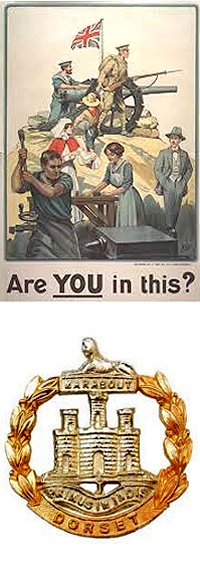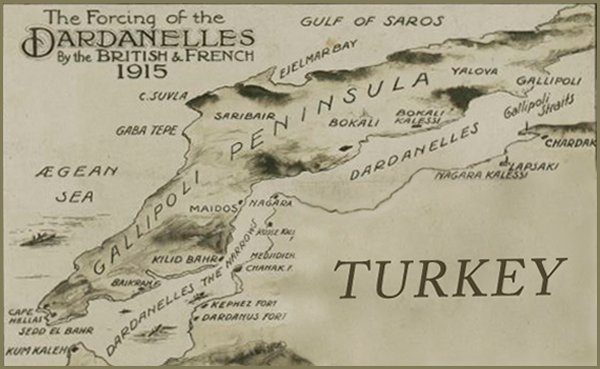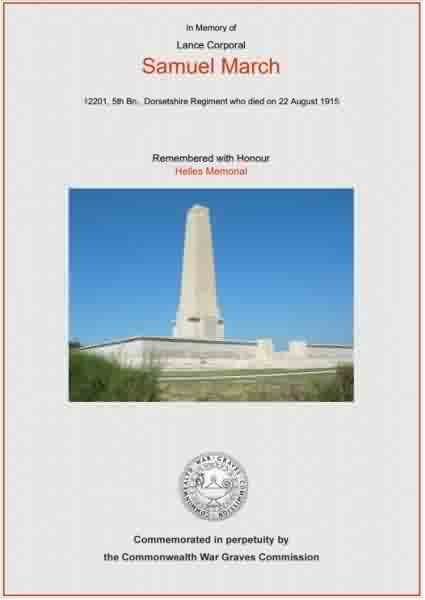yeovil at War
samuel March
Died from wounds sustained during the Gallipoli Campaign
Samuel March was born in Marston Magna in 1885, the son of farm labourer John March and Sarah Ann née Herridge. John and Sarah had ten children; Eliza Ann Herridge (b1875), George Thomas (b1877), Jane Elizabeth (b1882), William (b1885), Walter Henry (b1887), Samuel, Arthur John (1890-1938), Eamon Albert (b1893), Ernest (b1894) and Lilly (b1897). In the 1891 census the family were at Little Marston. They were still there in 1901.
On 26 December 1907, at Holy Trinity church in Peter Street, Samuel married Annie Maud Gillingham. At the time of their marriage Samuel was employed as a dairyman and was still living in Marston Magna. After the marriage the couple set up home at 104 Sherborne Road and Samuel worked for Petters Ltd. Samuel and Annie were to have one child.
 Samuel
enlisted at
Yeovil on 28
September 1914.
He joined the
5th (Service)
Battalion,
Dorsetshire
Regiment
(Service No
10892). His
Service Number
was 12201. From
his enlistment
papers it
appears that
Samuel had
previously spent
two years and
nine months in
the Royal
Garrison
Artillery
Volunteers, from
which he
ultimately
resigned.
Samuel
enlisted at
Yeovil on 28
September 1914.
He joined the
5th (Service)
Battalion,
Dorsetshire
Regiment
(Service No
10892). His
Service Number
was 12201. From
his enlistment
papers it
appears that
Samuel had
previously spent
two years and
nine months in
the Royal
Garrison
Artillery
Volunteers, from
which he
ultimately
resigned.
The 5th Battalion had been raised in Dorchester in August 1914. Formed entirely of Kitchener Volunteers from the county, the 5th Battalion left England on 3 July 1915 aboard the 'Aquitania', as a part of the 11th Division, sailing to Lemnos. Here they became acclimatised to the conditions by digging wells for the growing force and making roads. However, a virulent stomach bug laid many low and was a portent of things to come in the Suvla trenches.
The 5th Dorsets were to land at Suvla Bay, Gallipoli Peninsula, on 6/7 August 1915, under cover of a moonless night, as 34th Brigade's second wave. However, the plan miscarried when the leading landing craft headed too far south and ran aground shoals. With Turkish troops alerted, the delays and the inexperienced British Brigades unable to find their objective at Hill 10 in the pitch black, there was paralysis. The Dorsets later commented on the performance of their Brigade Headquarters "From the first things that had gone wrong, the misfortune which had attended the landing of the landing.... and had led to.... everything being thrown out of gear; where resolute handling and vigour were urgently needed, resolution and initiative had been conspicuously lacking."
It wasn't until dawn that 5th Dorsets landed and the Battalion headed north to mount a flanking attack on Hill 10 that was now only too obvious from the flashes of Turkish gunfire. 'A' Company gave covering fire from the dunes, while the remainder of the Battalion pressed forward up the gentle slopes of the hill in short well rehearsed rushes. The Turkish battalion fled and at 0600 hours, Hill 10, which should have been captured by another unit hours earlier, was in the hands of the Dorsets.
The Turks withdrew and the Dorsets followed. After a sharp firefight, Hill 28, a mile across the Suvla Plain, was captured when the Turks 'lacking the stomach for a close quarter bayonet fight' again withdrew in the face of 5th Dorset's seemingly relentless advance. Casualties had been relatively light but to advance further would have isolated the Battalion, as other units were still well behind the Dorsets. Unfortunately, there was no water on Hill 28 and the men spent the day sweltering in the sun and without information or orders, the Commanding Officer went back to find the Brigadier at the beach. Meanwhile, patrols were dispatched into the gullies leading down from the ridge to the left, while half the Battalion provided flank support to a chaotic attack mounted by the rest of their Division on the Chocolate Hill area. Overall, the Suvla landing had fallen well below expectation but 5th Dorsets had done all that had been asked of them and more. The verdict of the day was ".... when energy and determination might have retrieved the situation, inactivity and depression had prevailed in Brigade Headquarters.... and much that might have been secured had been left untaken."
The following day the force re-organised units, which were badly mixed up, before renewing the attack on 9th August. This time the Dorsets were to advance across the broken gullies of the Kiretch Tepe Ridge, which was to be cleared by the 10th Irish Division. The advance on the crest of the main ridge went well, if slowly, and lower down the enemy were soon falling back as the Dorsets fought their way from gully to gully towards the foot of Kidney Hill. Here they halted to await clearance of the ridge above but the Munster Fusiliers, on their flank, were forced to withdraw precipitately. The Dorsets were short of water but the Battalion's pioneers brought supplies up from the beach and distributed bottles of water under heavy fire. However, with their flanks in the air the Dorsets were ordered to withdraw. In their first battles the inexperienced 5th Dorsets had performed well.
On 22 August 1915 Samuel, by this time promoted to Lance Corporal, was severely wounded in action. He died from his wounds while on a hospital ship that same day and was buried at sea. He was 27 years old.
In its edition of 10 September 1915 the Western Gazette reported "Mrs March, who resides at 104 Sherborne Road, received intimation from the Infantry Record Office on Thursday morning that her husband, Lance Corporal S March has been wounded in action on August 22nd, whilst serving with the 5th Dorsets at the Dardanelles."
However, in its edition of 17 September the Western Gazette reported "Mrs March, of 104 Sherborne Road, has now been notified that her husband Lance Corporal S March, who was reported in our last issue to have been wounded in action with the 5th Dorsets at the Gallipoli Peninsular, died of his wounds whilst on a hospital ship, and was buried at sea. Previous to the war, Lance Corporal March was employed by Messrs. Petters Ltd., and had been at the Dardanelles about six weeks. General sympathy is expressed for the widow who is left with one child Mrs. March, who resides at 104 Sherborne Road, wishes to thank all kind friends for their deepest sympathy in her sad loss."
Samuel March is commemorated on Panels 136-139 of the Helles Memorial and his name is recorded on the War Memorial in the Borough.
gallery

The record of Samuel and Annie's marriage in the register of Holy Trinity.

A postcard dated 1915 showing a map of the Dardanelles Campaign.

The Commonwealth War Graves Commission certificate in memory of Samuel March.